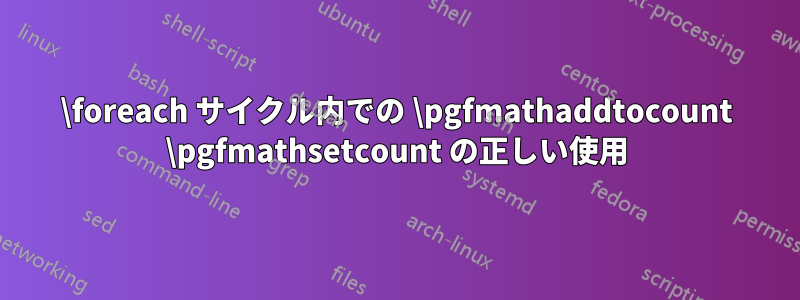

写真を見ると大体のことは分かると思いますが、解決策の匂いはするのですが、はっきりとはわかりません...カウンターが役に立つと思います。もしそうでなければ候補者を 1 人見つけてください。ご協力いただければ幸いです。
\documentclass{article}
\usepackage{tikz}
\usepackage{xcolor}
\usepackage{xifthen}
\begin{document}
\begin{tikzpicture}
\tikzstyle{titmarg}=[yshift=4cm]
\tikzstyle{textmarg}=[yshift=-5cm]
\tikzstyle{questmarg}=[yshift=-6cm]
\tikzstyle{descmarg}=[xshift=0cm,yshift=3.5cm]
\tikzstyle{lefmarg}=[xshift=-1.5cm]
\tikzstyle{rigmarg}=[xshift=1.5cm]
\newcommand*{\margine}{4}%
\newcommand*{\scala}{.1}%
\newcommand*{\prove}{200}%
\newcommand*{\side}{1.5}%
%\newcommand*{\checkzero}{0};
%\newcommand*{\checkuno}{0};
\pgfmathsetmacro{\scaleside}{\side*.1}%
\path[] (-\scaleside,-\scaleside) rectangle (\scaleside,\scaleside);
\shadedraw[thick,inner color=white,outer color=red!10] (-\side,-\side) rectangle (\side, \side) node [midway] (centro) {};
\node at (centro) [above,titmarg,draw,scale=2] {\textbf{Area hit and miss}};
\node at (centro) [above,textmarg,text width=9cm] {I want to approximate $\pi$ with $\frac{{\color{green}\# \text{hit}}}{{\color{green}\# \text{hit}}+{\color{red}\# \text{miss}}}$ as $N\to\infty$, where $N={\color{green}\# \text{hit}}+{\color{red}\# \text{miss}}$.};
\node at (centro) [above,questmarg] {What is the correct using of \emph{pgfmathaddtocount} or similar inside a \emph{foreach} cycle?};
\node at (centro) [descmarg,draw,fill=yellow!50] {$N=\prove$ trials};
\shade[inner color=white,outer color=green!20] (0,0) circle (1);
\foreach \k in {0,...,\prove}
{
\pgfmathsetmacro{\x}{\side*rand}%
\pgfmathsetmacro{\y}{\side*rand}%
\pgfmathsetmacro{\distance}{sqrt(\x*\x+\y*\y)}%
\ifthenelse{1 > \distance}
{
\shade[inner color=green,outer color=white] (\x,\y) {} circle (2pt);
%\pgfmathaddtocount{\the\checkuno}{1}
}
{
\shade[inner color=red,outer color=white] (\x,\y) {} circle (2pt);
%\pgfmathaddtocount{\the\checkzero}{1}
}
\fill[] (\x,\y) {} circle (.1pt);
}
%\draw[] (0,0) circle (1);
%
\end{tikzpicture}
\end{document}
答え1
あなたが直面しているカウンターの問題は、TeXとLaTeXのカウンター設定です。詳細はこちらをご覧ください。TeX カウントと LaTeX カウンターの違いは何ですか?
PGF/TikZ は TeX 方式で実行され、foreach ループは各スピンごとにグループを設定するため、グループ外の変更は保持されません。Peter Grill の提案を使用するか、カウント操作をグローバルに宣言することができます。
\documentclass[tikz]{standalone}
% TikZ is loaded so is xcolor already.
\newcount\checkzero
\newcount\checkuno
\begin{document}
\begin{tikzpicture}[titmarg/.style={yshift=4cm},
textmarg/.style={yshift=-5cm},
questmarg/.style={yshift=-6cm},
descmarg/.style={xshift=0cm,yshift=3.5cm},
lefmarg/.style={xshift=-1.5cm},
rigmarg/.style={xshift=1.5cm}]
\newcommand*{\margine}{4}%
\newcommand*{\scala}{.1}%
\newcommand*{\prove}{200}%
\newcommand*{\side}{1.5}%
\pgfmathsetmacro{\scaleside}{\side*.1}%
\path[] (-\scaleside,-\scaleside) rectangle (\scaleside,\scaleside);
\shadedraw[thick,inner color=white,outer color=red!10] (-\side,-\side) rectangle (\side,\side) node [midway] (centro) {};
\node at (centro) [above,titmarg,draw,scale=2] {\textbf{Area hit and miss}};
\node at (centro) [above,textmarg,text width=9cm] {I want to approximate $\pi$ with $\frac{{\color{green}\# \text{hit}}}{{\color{green}\# \text{hit}}+{\color{red}\# \text{miss}}}$ as $N\to\infty$, where $N={\color{green}\# \text{hit}}+{\color{red}\# \text{miss}}$.};
\node at (centro) [above,questmarg] {What is the correct using of \emph{pgfmathaddtocount} or similar inside a \emph{foreach} cycle?};
\node at (centro) [descmarg,draw,fill=yellow!50] {$N=\prove$ trials};
\shade[inner color=white,outer color=green!20] (0,0) circle (1);
\foreach \k in {1,...,\prove}% Starting from 0 makes N+1 samples
{
\pgfmathsetmacro{\x}{\side*rand}%
\pgfmathsetmacro{\y}{\side*rand}%
\pgfmathsetmacro{\distance}{sqrt(\x*\x+\y*\y)}%
\pgfmathparse{1 > \distance?int(1):int(0)}
\ifnum\pgfmathresult>0\relax% You can test with PGF ifthenelse as above
\shade[inner color=green,outer color=white] (\x,\y) {} circle (2pt);
\global\advance\checkuno by1\relax
\else
\shade[inner color=red,outer color=white] (\x,\y) {} circle (2pt);
\global\advance\checkzero by1\relax
\fi
\fill[] (\x,\y) {} circle (.1pt);
}
\node[align=left] (a) at (0,-3) {0 : \the\checkzero\\1 : \the\checkuno};
\end{tikzpicture}
\end{document}

答え2
の構文\pgfmathaddtocountは
\pgfmathaddtocount{<TeX counter>}{<expression>}
だから、
\newcount\checkuno
前文では、
\pgfmathaddtocount{\checkuno}{1}
動作します。ただし、サイクルはグループで実行されるため、サイクルが終了するとすぐに\foreach設定が忘れられてしまうことを覚えておく必要があります。\checkuno
を使用する\global\advance\checkuno by 1とうまくいきますが、式では機能しません。この場合は間接的な方法を使用できます。
\newcount\temporary
\newcount\checkuno
前文と
\temporary=\checkuno
\pgfmathaddtocount{\temporary}{<expression>}
\global\checkuno=\temporary
サイクルの中で。
答え3
TikZmathライブラリの使用はいかがでしょうか。TeX スコープを使用しない for ループと、その他の便利な機能を提供します。ただし、PGF の最新リリースが必要です。
\documentclass[tikz,border=5]{standalone}
\usetikzlibrary{math}
\begin{document}
\begin{tikzpicture}[%
titmarg/.style={yshift=4cm},
textmarg/.style={yshift=-5cm},
questmarg/.style={yshift=-6cm},
descmarg/.style={xshift=0cm,yshift=3.5cm},
lefmarg/.style={xshift=-1.5cm},
rigmarg/.style={xshift=1.5cm}
]
\tikzmath{%
\margine = 4;
\scala = .1;
\prove = 200;
\side = 1.5;
\scaleside = \side * .1;
}
\path (-\scaleside,-\scaleside) rectangle (\scaleside,\scaleside);
\shadedraw [thick,inner color=white,outer color=red!10]
(-\side,-\side) rectangle (\side, \side) node [midway] (centro) {};
\node at (centro) [above, titmarg,draw,scale=2] {\textbf{Area hit and miss}};
\node at (centro) [descmarg,draw,fill=yellow!50] {$N=\prove$ trials};
\shade[inner color=white,outer color=green!20] (0,0) circle (1);
\tikzmath{%
integer \checkuno, \checkzero;
\checkuno = 0;
\checkzero = 0;
for \k in {1,...,\prove}{
\x = \side * rand;
\y = \side * rand;
\distance = veclen(\x, \y);
if (1 > \distance) then {
\checkuno = \checkuno + 1;
{
\shade[inner color=green,outer color=white] (\x,\y) {} circle (2pt);
};
} else {
\checkzero = \checkzero + 1;
{
\shade[inner color=red,outer color=white] (\x,\y) {} circle (2pt);
};
};
{
\fill[] (\x,\y) {} circle (.1pt);
};
};
}
\node[align=left] (a) at (0,-3) {0 : \checkzero\\1 : \checkuno};
\end{tikzpicture}
\end{document}



